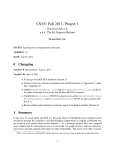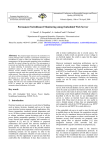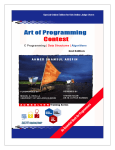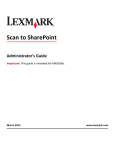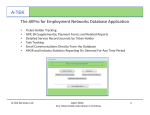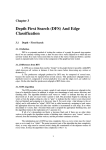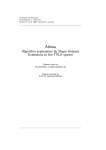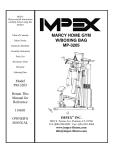Download CS351 Fall 2011, Project 1 Baconator
Transcript
CS351 Fall 2011, Project 1
Baconator
a.k.a., The Six Degrees Machine
MondoSoft, Inc.
STATUS Specification and requirements document
VERSION 1.0
DATE Aug 23, 2011
0
Changelog
Version 1.0 Initial release. Aug 23, 2011.
1
Summary
In the wave of social media and Web 2.x, the great minds of MondoSoft (your employer) have
decided to leverage the company’s core data-handling competencies by forging a bold path into
the world of user content-driven media analytics.1 As a prototype project, they have assigned
you to build a tool for analyzing the movie social graph: the graph of actors, actresses, directors,
and movies and who-worked-with-whom-on-what relationships. The goal is to be able to answer
business value-added queries about the movie social graph in realtime for high-revenue-generating
customers.2
You have caught the lucky job of designing and building the Baconator, a prototype data
loader and query tool. This tool will be able to read conveniently-formatted flat text file data files
describing the actresses, directors, actors, movies, and their relationships, and it will provide a
state of the art3 text-mode command-line interface. Finally, in order to maximize revenues4 , the
big bosses have decreed that you will implement the underlying graph data structure and analysis
routines as separate, generic modules that can be reused in other products or sold as a standalone
library.
1
That is, movie data are worth big $$$, and the big bosses are too lazy to type in all the movie data themselves.
I.e., the big bosses want to be able to win at the “Six degrees from Kevin Bacon” game at their cocktail parties.
3
State of the art for 1975, anyway.
4
Sell your blood, sweat, and tears twice.
2
1
Contents
0
Changelog
1
1
Summary
1
2
Group/Individual Effort
3
3
Java Language Level
3
4
Libraries and Support Code
3
5
Definitions
3
6
Requirements
6.1 Package and File Names . . . . . . . . .
6.2 Format of the SUBMISSION ARCHIVE .
6.3 The IMDB Movie Data . . . . . . . . . .
6.4 The Movie Graph Data Structure . . . . .
6.5 The Movie Database . . . . . . . . . . .
6.6 The MovieGraphAnalyzer Class . .
6.7 The Lexical Analyzer and Parser . . . . .
6.8 The Command-Line Interpreter (CLI) . .
.
.
.
.
.
.
.
.
.
.
.
.
.
.
.
.
.
.
.
.
.
.
.
.
.
.
.
.
.
.
.
.
.
.
.
.
.
.
.
.
.
.
.
.
.
.
.
.
.
.
.
.
.
.
.
.
.
.
.
.
.
.
.
.
.
.
.
.
.
.
.
.
.
.
.
.
.
.
.
.
.
.
.
.
.
.
.
.
.
.
.
.
.
.
.
.
.
.
.
.
.
.
.
.
.
.
.
.
.
.
.
.
7
Quantitative Requirements
8
Deliverables
8.1 Turnin Process . . . . . . . . . . . . . . . . . . . . . . . . . . . .
8.2 Milestone 1: JUnit Test Suites . . . . . . . . . . . . . . . . . . .
8.3 Milestone 2: MovieGraph and MovieGraphAnalyzer Classes
8.4 Milestone 3: Lexical Analysis and Parsing . . . . . . . . . . . . . .
8.5 Final Rollout: Full Baconator Suite . . . . . . . . . . . . . . . .
.
.
.
.
.
.
.
.
.
.
.
.
.
.
.
.
.
.
.
.
.
.
.
.
.
.
.
.
.
.
.
.
.
.
.
.
.
.
.
.
.
.
.
.
.
.
.
.
.
.
.
.
.
.
.
.
.
.
.
.
.
.
.
.
6
6
7
8
9
10
10
11
12
16
.
.
.
.
.
.
.
.
.
.
.
.
.
.
.
.
.
.
.
.
.
.
.
.
.
.
.
.
.
.
.
.
.
.
.
.
.
.
.
.
17
18
18
19
20
21
9
Due Dates
22
A
IMDB File Grammars
23
A.1 IMDB File Grammars . . . . . . . . . . . . . . . . . . . . . . . . . . . . . . . . . 23
A.2 Command Line Interpreter Grammar . . . . . . . . . . . . . . . . . . . . . . . . . 23
B
The Floyd-Warshall Algorithm
25
C
Single-Source Graph Searches
26
2
2
Group/Individual Effort
This project is an individual programming project. Refer to the CS351 Fall 2011 Syllabus and
FAQ for details on what this means.
3
Java Language Level
You MUST write this project in Java 1.5.x (a.k.a., “the Java 5 platform”) or a later version. Your
code MUST support generic classes where required by the required project interfaces.
4
Libraries and Support Code
DEVELOPERs MAY use any objects or functions available through the Java 1.5.x or 1.6.x SE
JDK.
DEVELOPERs MUST use a number of objects and functions provided by the instructors in
the cs351 p1 support code.v1.0.jar library file. The specific objects/functions will be
discussed throughout this document.
DEVELOPERs MUST use the JUnit 4 (or later) library for unit testing.
DEVELOPERs MUST NOT use any other libraries or code, beyond those listed here, without
prior permission from the CS351 instructors.
5
Definitions
The following definitions will be used in this document:
ACTOR A person named in the actors.list file. A type of ENTITY.
ACTRESS A person named in the actresses.list file. A type of ENTITY.
CLOSED SET The set of NODEs that have already been examined in a graph search such as a
breadth-first or depth-first search. Each node generated by the search (including the start
node) is added to the OPEN QUEUE if, and only if, it is not already in the CLOSED SET.
This prevents cycling by ensuring that each NODE is enqueued on OPEN only once.
CLI Command-line interpreter; a simple, text-mode user interface to the Baconator program.
DEVELOPER The project designer, programmer, tester, and documenter. You.
DIRECTOR A person named in the directors.list file. A type of ENTITY.
EDGE An arc (or pointer) between two NODEs in a GRAPH. In the Baconator database
GRAPH, an EDGE is represented via an “acted in/contained actor—actress” or “directed/was
directed by” relation in one of the supported IMDB data files. Each edge has an origin (a.k.a.,
parent, top, or, from) NODE and a destination (a.k.a., child, bottom, or to) NODE. An EDGE
3
is allowed to start and end at the same NODE — this is called a self-EDGE. The destination
(to) of an EDGE is considered to be the NEIGHBOR of the origin (from).
Note: In the IMDB data, self-edges should be impossible, as people can only act in/direct
movies, while movies cannot act in/direct themselves. Therefore, the IMDB data graph is
a bipartite graph — its nodes can be divided into two classes (people and movies) and all
edges pass between these classes.
EDGE SET The collection of all EDGEs in a graph. Formally written E = {(vi , vj ) ∈ V × V :
vi is connected to vj }. The size of the EDGE SET, |E|, is the total number of EDGEs in the
GRAPH.
EDGEs may be either directed or undirected. In the Baconator project, the underlying
Graph data structure is a directed graph data structure – every EDGE as a “start” and an
“end” NODE. However, the IMDB data relations are considered to be undirected — if person
A acted in movie B, then movie B contains actor/actress B. This should be represented by
adding both edges (A, B) and (B, A) via two calls to Graph.addEdge().
ENTITY A logical entity (a “thing”) in the IMDB data domain. ENTITIES form the NODEs of
an undirected relationship GRAPH whose edges have semantics like “acted in”, “directed”,
etc. Baconator MUST support at least the ENTITIES ACTRESS, ACTOR, DIRECTOR,
and MOVIE. It MAY also support additional entity types (such as FX company), at the
DEVELOPER’s discretion.
GRAPH An abstract data structure containing two types of entities: NODEs (a.k.a., vertices) and
EDGEs (a.k.a., arcs). A GRAPH is a generalization of a list or a tree, that allows NODEs
to be connected arbitrarily. The IMDB data is a moderately large GRAPH, composed of
ENTITIES and acted-in/directed EDGEs. Formally, a GRAPH is often written G = hV, Ei,
where V is the NODE SET (or vertex set) and E is the EDGE SET.
Note: In the IMDB data, all edges are considered to be bidirectional — if person A acted
in movie B, then both (A, B) and (B, A) are EDGEs in the GRAPH. However, the underlying graph data structure is a directed graph data structure, so this will require two
Graph.addEdge() calls — one to add the (A, B) EDGE and one to add the (B, A)
EDGE.
EXTRA CREDIT Denotes an opportunity for optional extra credit. The amount of extra credit
assigned will depend on the scope and challenge of the implemented feature. However, be
sure to see the class policy on extra credit in the CS351 FAQ.
All EXTRA CREDIT features introduced by the DEVELOPER MUST be appropriately
documented in USER and INTERNAL DOCUMENTATION.
Note: Opportunities for EXTRA CREDIT noted in this document are not exhaustive — we
are open to other extra credit ideas.
INDEGREE The INDEGREE of a NODE, v, in a GRAPH is defined to be the total number of
EDGEs that end at v. That is, the number of EDGEs for which v is a child. Formally,
indegree(v) = |{e = (vi , v) : e ∈ E}|. Note that the INDEGREE does count self-EDGEs.
4
INTERNAL DOCUMENTATION Documentation of the design, structure, behavior, and public/protected interface of the program code. Includes internal code comments, Javadoc API
documentation, and external, human-level design documentation.
MAY A requirement that the product can choose to implement if desired. Can also indicate a
choice among acceptable alternatives (e.g., “The program MAY do x, y, or z.” indicates that
the choice of behavior x, y, or z is up to the designer.)
MOVIE A movie ENTITY listed in one of the actors.list, actresses.list, or directors.list
data files.
MUST A requirement that the product must implement for full credit.
MUST NOT A behavior or assumption that must not be violated. Violating a MUST NOT restriction will result in a penalty on the assignment.
NEIGHBOR A neighbor of NODE vi in the GRAPH is a NODE vj that is connected to vi by an
EDGE starting at vi . That is, vj is a NEIGHBOR of vi iff there is an edge from vi to vj : vj is
neighbor of vi ⇔ (vi , vj ) ∈ E.
For example, in the IMDB data, if person A acted in movie B, then B is a NEIGHBOR of
A.
NEIGHBOR SET The NEIGHBOR SET of a NODE vi is the set of all NEIGHBOR nodes to vi :
NeighborSet(vi ) = {vj : (vi , vj ) ∈ E}
NODE A vertex in a GRAPH. In the Baconator data graph, NODEs are represented by ENTITIES. A NODE has zero or more outgoing EDGEs and zero or more incoming EDGEs.
(See: INDEGREE and OUTDEGREE.)
OPEN LIST The ordered set of NODEs that have been generated, but not yet examined, by a
graph search such as a breadth-first or depth-first search. The OPEN LIST represents the set
of “upcoming” NODEs that need to be examined later in the search, sorted by the priority
that they’ll be looked at.
Note: While this is commonly referred to as “the open list”, it need not literally be a list data
structure. It should be whatever data structure is appropriate to the search in question. See
Appendix C.
OUTDEGREE The OUTDEGREE of a NODE, v, in a GRAPH is defined to be the total number
of EDGEs that start at v. That is, the number of EDGEs for which v is a parent. Formally,
outdegree(v) = |{e = (v, vi ) : e ∈ E}|.
RECOVERABLE ERROR An error condition that the software can ignore, correct, or otherwise
recover from. The program MUST produce a warning message and then cleanly continue
with no corruption or loss of valid data.
RELATIONSHIP An interaction between exactly two ENTITIES. In the IMDB data, RELATIONSHIPs may be “acted in”, “directed”, “contained actor/actress”, or “was directed by”.
The RELATIONSHIPs are represented by EDGEs in a GRAPH data structure.
5
SHOULD A requirement that is recommended, but not required. The designer may violate a
SHOULD requirement, but should be prepared to explain why.
SUBMISSION ARCHIVE The archive file that the CONTRACTOR turns in for each milestone.
The SUBMISSION ARCHIVE MUST be a .jar file. The SUBMISSION ARCHIVE file
MUST be named lastname_p1[milestone](version).[jar] where [milestone]
indicates which milestone is being submitted (m1, m2, m3, r). The (version) string is
optional; if present, it indicates which version of a milestone is being submitted, in case the
CONTRACTOR wishes to submit a revised version of the milestone.
Examples of valid SUBMISSION ARCHIVE names are lane_p1m1.jar and lane_p1r_v2.jar.
See Section 6.2 for details on the directory structure of the .jar file.
UNRECOVERABLE ERROR An error condition from which recovery is impossible. The program MUST produce an error message describing the condition and then cleanly halt. The
program MUST NOT crash, core-dump, display a stack trace, dump a raw exception to the
screen, or corrupt any stored data.
USER DOCUMENTATION One or more human-readable documents that describe the use of
the Baconator program, in terms comprehensible by non-experts and non-programmers.
USER DOCUMENTATION MUST include the file user doc.extension (for an appropriate value of extension), and MAY include a README.TXT, CHANGELOG.TXT, or
BUGS.TXT file. Where appropriate, USER DOCUMENTATION also includes in-program
help features (such as the help command of Section 6.8).
USER DOCUMENTATION is as opposed to INTERNAL DOCUMENTATION.
6
Requirements
This section describes the elements that MUST be developed as part of this project. The designer
MAY also choose to implement additional Java source files, programs, and/or shell scripts in support of the following items. This section only describes the general performance requirements for
each element; for specific deliverable requirements, please refer to Section 8.
The Baconator project comprises one main program (the Baconator program itself) as
well as necessary supporting and test files. In addition to the “performance” code of this project,
you will also develop a complete set of test cases and test code for all elements of the project.
Some of this MUST be in JUnit, but it will probably prove necessary to have external (e.g., shell
script) test suites as well.
6.1
Package and File Names
The designer MUST use at least the following packages
unm.cs351.p1
All program class files specified in this document
(Baconator.java, MovieGraph.java, etc.)
unm.cs351.p1.test All JUnit test files
The designer MAY offer additional packages. Any additional packages MUST be sub-packages
of unm.cs351.p1, and all such packages MUST be documented in README.TXT.
6
6.2
Format of the SUBMISSION ARCHIVE
The SUBMISSION ARCHIVE MUST be a jar file containing the following top-level directories:
src/ Root of all source code (package) directories.
bin/ Root of all compiled .class file directories.
doc/ Contains all USER DOCUMENTATION and all human-readable INTERNAL DOCUMENTATION (such a design documents).
api-doc/ Contains all INTERNAL DOCUMENTATION generated from Javadoc (i.e., documentation of the code itself).
The SUBMISSION ARCHIVE MAY, in addition, contain any of the following:
data/ Directory containing any data used by test scripts. However, the submitted archive MUST
NOT contain more than 1 Mb of data. (The DEVELOPER is free to use as much test data as
she/he pleases on personal machines, but MUST NOT turn in entire, raw IMDB data files.)
scripts/ Any non-java scripts or supporting configuration files. Examples include ant scripts
or Eclipse wizard xml configuration files.
The SUBMISSION ARCHIVE MAY contain other top-level directories, at the DEVELOPER’s
discretion, but the purpose of all such directories MUST be documented in the USER DOCUMENTATION (e.g., in the README.TXT file.)
The SUBMISSION ARCHIVE MUST NOT contain any of the following:
• The Eclipse .classpath or .project files.
• Any Subversion, CVS, git, SCCS, or other revision control system meta-data directories or
files.
• Any of the content of the cs351 p1 support code.v1.0.jar (or the entire
cs351 p1 support code.v1.0.jar itself). DEVELOPERs may assume that their
code is being run in an environment in which the cs351 p1 support code.v1.0.jar
is on the Java CLASSPATH.
Hint: To configure Eclipse to access a jar file (such as cs351 p1 support code.v1.0.jar)
from a project, select the project name in the package explorer, pick “Properties” from
the context menu, go to Java Build Path→Libraries→Add External Jars,
and browse to the location where you have stored the cs351 p1 support code.v1.0.jar
file.
For rollout (Section 8.5), the SUBMISSION ARCHIVE SHOULD be an executable archive.
That is, running
java -jar lastname_p1r.jar
SHOULD run the Baconator program.
7
6.3
The IMDB Movie Data
Important: IMDB Intellectual Property Rights Requirements
For this project, we will be using data made freely available by the Internet Movie Database
(IMDB). Access to the data is predicated on a number of terms and conditions specified by
IMDB at:
http://www.imdb.com/help/show_leaf?usedatasoftware
Additional terms MAY be attached to the header/footer info of a given IMDB data file.
Some key terms are reproduced here, however, all students MUST obey all IMDB-specified
terms and conditions. The full terms and conditions given at the master IMDB site, above, supersede any given here; any discrepancies between them MUST be resolved in favor of IMDB.
• All data used in this project and all software developed as part of this project are NONCOMMERCIAL. You MUST NOT sell, rent, republish, or repost any of IMDB’s data
or any software arising from this project.
• You MUST NOT redistribute the software you develop for this project outside of this
class. (See also the CS351 FAQ in the course syllabus.)
• You MUST NOT robotically access IMDB’s site or its data. All IMDB files MUST be
individually manually downloaded.
• If you are in any way uncomfortable using IMDB’s data, you are not required to use it.
On request, the course instructors will make synthetic, non-IMDB data available to you.
You MUST make such a request at least five days before the due date of Milestone 3.
The raw text movie data files are available via FTP download from one of a number of FTP
sites. The FTP sites are listed on IMDB’s “Alternative Interfaces” page, under “Plain Text Data
Files”:
http://www.imdb.com/interfaces#plain
The Baconator program MUST support at least the following files, or correctly structured
extracts of them:
• actors.list
• actresses.list
• directors.list
Extra Credit: Support additional IMDB file types. The magnitude of the extra credit will be
related to the complexity of such files, which fields are extracted from them, etc. All additional
file types MUST be documented in the USER DOCUMENTATION and via the help command
(Section 6.8).
For each of these files, the Baconator program MUST be capable of parsing the entire file,
according to the grammar given in Appendix 9. These files are rather complex, so it is not required that Baconator extract all fields from them. At a minimum, Baconator MUST extract
ENTITY (ACTRESS, ACTOR, DIRECTOR, MOVIE) names from the file, and the relationships
among them (acted-in, directed, contained-actor/actress, was-directed-by).
8
Extra Credit: Extract and store additional fields from the supported file types. How Baconator
chooses to handle such fields is up to the DEVELOPER, however to receive the extra credit, they
must be stored in the database as separate info (i.e., not simply string concatenated on to a person
or movie name) and the CLI (Section 6.8) MUST provide some way to access/use them. Any such
field extensions MUST be documented in the USER DOCUMENTATION.
Each of these files starts with a header and ends with a footer. While those sections contain a great deal of information that is useful to humans, it is all irrelevant to the Baconator.
Baconator MUST be capable of ignoring the content of the file headers and footers and still
correctly parsing and interpreting the data content of the files.
Baconator MAY treat a file lacking a header and/or footer as malformed. If so, it MUST
treat this case as a RECOVERABLE ERROR. At the DEVELOPER’s discretion, Baconator
MAY treat such files as syntactically correct (so long as the rest of the data is correctly formatted).
6.4
The Movie Graph Data Structure
Baconator’s primary jobs are to maintain a data structure representing ENTITIES and their
RELATIONSHIPs, extracted from the IMDB, and to provide an interface allowing a user to query
that data.
Conceptually, the RELATIONSHIP data forms a GRAPH — a mathematical/algorithmic data
structure that encodes ENTITIES (ACTORs, ACTRESSes, DIRECTORs, MOVIEs) as GRAPH
NODES and their RELATIONSHIPs as GRAPH EDGEs. The supported RELATIONSHIPs are
those captured in the supported IMDB text data files (Section 6.3). Specifically, Baconator
MUST recognize and encode:
• ACTRESS acted-in MOVIE
• MOVIE contained ACTRESS
• ACTOR acted-in MOVIE
• MOVIE contained ACTOR
• DIRECTOR directed MOVIE
• MOVIE was-directed-by DIRECTOR
Extra Credit: Baconator MAY support other ENTITIES and/or RELATIONSHIPs. For example, Baconator MAY support special effects companies as ENTITIES or produced as a RELATIONSHIP. Any such additions MUST be supported at the data structure level, MUST be queryable
at the CLI level, and MUST be documented in the USER DOCUMENTATION and appropriate INTERNAL DOCUMENTATION.
While the RELATIONSHIPs are given unidirectionally in the IMDB files (director A directed
movie B), Baconator MUST treat them as bidirectional. That is, whenever Baconator encounters a RELATIONSHIP of the form A related-to B, it MUST insert both (A, B) and (B, A)
into its EDGE SET. (Effectively, Baconator is treating the data as an undirected graph, even
though it is described as a directed graph.)
9
Extra Credit: Baconator MAY support EDGE and/or NODE annotations. These are additional, meta-data attached to each EDGE and/or NODE. For example, the actresses.list
and actors.list files often provide “role” notations (e.g., “Hamill, Mark (I)” appeared in
“Star Wars (1977)” as “[Luke Skywalker]”.) These could be encoded as meta-data attached to
EDGES. Any such additions MUST be supported through the CLI (Section 6.8) and documented
through appropriate USER and INTERNAL DOCUMENTATION.
The DEVLOPER’s version of Baconator MUST include a MovieGraph .java file implementing the Graph<T> interface from the cs351 p1 support code.v1.0.jar library.
Baconator MAY include additional .java files supporting the MovieGraph code.
The Graph<T> interface is generic — a Graph is a container (or collection, in Java terminology) that can contain an arbitrary type of content object. The MovieGraph implementation
MUST remain generic.
Note that the Graph<T> interface does not include any ways to explicitly represent the types
of NODES (ENTITIES) or EDGES (RELATIONSHIPS) – the Graph<T> treats NODES and
EDGES as homogeneous and untyped. To record information about ENTITY type (ACTRESS vs
ACTOR etc.) or RELATIONSHIP type (acted-in, directed, etc.), Baconator will use a Movie
Database class or classes (Section 6.5).
The Graph<T> will be Baconator’s internal representation of ENTITY and RELATIONSHIP data. The design of MovieGraph is at the DEVELOPER’s DISCRETION, however it
MUST obey all constraints documented in the Graph<T> API. (E.g., it must obey all asymptotic
time and space constraints.)
6.5
The Movie Database
The Baconator program MUST track the type of all ENTITIES. That is, it MUST distinguish between ACTRESSes, ACTORs, DIRECTORs, and MOVIEs. This is a level conceptually
above the Graph data structure (Section 6.4) and MUST NOT be explicitly represented in the
MovieGraph data structure code. The Baconator program MUST store this information in
auxiliary data structures. Those auxiliary data structures MAY be a separate class that encapsulates or references the Graph, or they MAY be represented via the type T that is stored in the
Graph.
At the minimum, Baconator MUST be able to report the number of unique ACTORs, ACTRESSes, DIRECTORs, and MOVIEs that it encounters.
Extra Credit: Baconator MAY provide additional functionality using the type information.
For example, it MAY allow search queries to be restricted by type (Section 6.8).
6.6
The MovieGraphAnalyzer Class
The ultimate objective of Baconator is to be able to answer queries like, “find the shortest path
between ENTITIES A and B” or “extract the set of all ENTITIES within 3 hops of ENTITY A”.
Rather than clutter the MovieGraph class with this functionality, the necessary analysis functions
are split out into the GraphAnalyzer<T> interface.
Like Graph<T>, GraphAnalyzer<T> is a generic interface — its concrete implementations operate on the same type of object contained in the Graph<T>. Since GraphAnalyzer
10
operates on the structure of the graph, rather than its contents, it does not require any additional
knowledge about the type T.
Baconator MUST provide a MovieGraphAnalyzer .java class implementing
GraphAnalyzer<T>. The MovieGraphAnalyzer concrete class MUST remain generic.
MovieGraphAnalyzer MUST implement all functions in the GraphAnalyzer interface,
though it may implement additional functions, at the DEVELOPER’s discretion. The DEVELOPER’s MovieGraphAnalyzer implementation MUST obey all asymptotic time and space
complexity constraints specified in the GraphAnalyzer<T> interface documentation.
Extra Credit: Provide additional graph analysis functionality. The magnitude of any extra
credit will depend on the scope, complexity, and correctness of the implemented functionality. Any
such additions MUST be appropriately documented in USER and INTERNAL DOCUMENTATION.
6.7
The Lexical Analyzer and Parser
In order to populate the movie database, Baconator needs to be able to read data out of the
IMDB text data files (Section 6.3), break them into ENTITIES, and infer the RELATIONSHIPs
between those entities. The process of decomposing raw text into grammatical (structural) relationships is called parsing, and it uses as a subroutine lexical analysis (or simply lexing).
Baconator MUST provide a lexical analyzer that implements the LexicalAnalyzer<T>
interface provided in the cs351 p1 support code.v1.0.jar library. The lexer MUST be
named BaconLexer .java. The BaconLexer MUST generate tokens conforming to the
Token interface of cs351 p1 support code.v1.0.jar, though the specific Token implementation is up to the DEVELOPER.
Baconator MUST provide at least three parsers implementing the Parser<S,T> interface
of the cs351 p1 support code.v1.0.jar library:
BaconParseActress Parse a complete actresses.list data file, or properly formed
fragment thereof, including handling (ignoring) headers and footers.
BaconParseActor Parse a complete actors.list data file, or properly formed fragment
thereof, including handling (ignoring) headers and footers.
BaconParseDirector Parse a complete directors.list data file, or properly formed
fragment thereof, including handling (ignoring) headers and footers.
All Parser<S,T> implementations MUST provide a single-argument constructor of the signature:
/*
* Initialize parser to read from specified file.
*/
public BaconParseFoo(String fileName) throws IOException,
ParseException;
where “Foo” is one of Actress, Actor, or Director.
Baconator MAY provide additional parsers and/or additional classes to support the parser
implementations, at the DEVELOPER’s discretion.
11
6.8
The Command-Line Interpreter (CLI)
The user interacts with the Baconator program and its database via a simple command-line
interpreter (CLI). Much like a UNIX or Windows terminal (shell) program, the CLI issues a command prompt and waits for the user to input a command. The CLI then interprets and executes the
command and displays any results of the command (possibly issuing a help message or an error
message). The whole prompt-command-interpret-response procedure takes place in a loop that
continues until the user issues a quit command.
The Baconator CLI MUST support at least the following commands. It MAY support additional commands, or extensions to these commands, at the DEVLOPER’s discretion. Any such
extensions MUST be documented in the USER DOCUMENTATION.
help Issue a concise summary of commands supported by the Baconator CLI and their respective syntaxes.
Syntax help
Input arguments None
Effect on database None
Output/display Display a help message, listing the usage message for every command.
load Load one or more files. Capable of loading either a saved binary file, or one of the
Baconator-supported text files.
Extra Credit: (small) Support loading from compressed files.
Syntax load fileType file [file]*
Input arguments fileType is one of the following:
actor Load an actors.list, or compatible fragment of one.
actress Load an actresses.list, or compatible fragment of one.
director Load an directors.list, or compatible fragment of one.
saved Load a pre-compiled, binary-format movie database file that was previously
saved with the save command.
file is the relative or absolute pathname of a data file to be loaded. (Note: Baconator
MUST support both relative and absolute path references to files.)
Effect on database Add the ENTITIES and RELATIONSHIPs found in the specified file(s)
to the internal database.
On Error An error in loading a file is considered a RECOVERABLE ERROR. Baconator
MUST issue an appropriate warning and continue (return to the CLI prompt), without
corrupting the database. A file MAY be partially loaded, but all ENTITIES and RELATIONSHIPS loaded MUST be correct. (E.g., Baconator MUST NOT store a
fragment of a name in a NODE or leave one end of an EDGE dangling.) In no case
must the database be corrupted by partially loaded data, nor must any existing data be
lost.
Extra Credit: Support transactional semantics for load: load a file completely or not
at all.
12
Output/display Messages at the beginning and completion of loading, indicating success.
Appropriate warning messages in the case of loading failure.
save Save internal database to a binary-format file, to be retrieved later via load.
Extra Credit: (small) Support loading from compressed files.
Syntax save fileName
Input arguments fileName: a relative or absolute path to the destination save file. (Note:
Baconator MUST support both relative and absolute path references to files.)
Effect on database None
On Error An error in saving a file is considered a RECOVERABLE ERROR. Baconator
MUST issue an appropriate warning and continue (return to the CLI prompt), without
corrupting the database. Baconator MUST NOT produce a corrupt or partial output
file – any such mangled outputs MUST be deleted.
Output/display Create the specified file, containing a binary image of the internal database.
Display at least messages at the beginning and completion of saving, indicating success.
Appropriate warning messages in the case of failure.
pwd Print the current working directory.
Syntax pwd
Input arguments None
Effect on database None
Output/display Display the current working directory: the directory with respect to which
all relative paths in load or save commands are resolved.
cd Change current working directory.
Syntax cd newdir
Input arguments newdir: a relative or absolute path to change to.
Effect on database No change to the database, but change Baconator’s notion of the
current working directory to the specified directory. After a successful cd command,
all relative pathnames MUST resolve with respect to the newly specified directory.
On Error Issue appropriate warning to the user and leave the working directory unchanged.
Output/display None, if successful.
ls List contents of current working directory.
Syntax ls
Input arguments None
Effect on database None
13
Output/display Print a sorted list of the contents of the current working directory, sorted
by name. Every entry SHOULD be printed with either the string ’dir’, to indicate a
subdirectory, or an indication of the size of the file.
stats Print a summary of the contents of the internal database.
Syntax stats
Input arguments None
Effect on database None
Output/display Print at least the following information about the database:
•
•
•
•
•
Count of the total number of unique ACTRESSes in the database.
Count of the total number of unique ACTORs in the database.
Count of the total number of unique DIRECTORs in the database.
Count of the total number of unique MOVIEs in the database.
Count of the total number of unique EDGEs in the database.
diam Report the diameter of the graph (the maximum, finite, distance between any pair of reachable nodes). If the graph has multiple, disconnected components, report the diameter of the
largest diameter component.
Syntax diam
Input arguments None
Effect on database None, though will compute auxiliary data structures in the process of
computing the graph diameter.
On error Errors in the diameter search are RECOVERABLE ERRORs. Print an appropriate warning message and return to the CLI prompt.
Output/display Print the diameter of the (largest diameter component) of the graph.
Baconator SHOULD issue a warning if the diam computation is expected to take
an unduly long time.
path length Print the length of the shortest path between two ENTITIEs.
Syntax path length from to
Input arguments
from Start node of the path search.
to End node of the path search.
Effect on database None, though will compute auxiliary data structures in the process of
computing the shortest path.
On error Errors in the shortest path search are RECOVERABLE ERRORs. Print an appropriate warning message and return to the CLI prompt.
Output/display Length of the shortest path between from and to. Special cases:
14
• If from==to, then the path length is 0.
• If to is not reachable from from, then the distance is infinite. Display a message
indicating that to is not reachable from from.
path Display all steps of the shortest path between two nodes.
Syntax path from to
Input arguments
from Start node of the path search.
to End node of the path search.
Effect on database None, though will compute auxiliary data structures in the process of
computing the shortest path.
On error Errors in the shortest path search are RECOVERABLE ERRORs. Print an appropriate warning message and return to the CLI prompt.
Output/display Display all ENTITIES along the shortest path starting at from and ending
at to, one per line. Note that both from and to are included in the shortest path, and
should be displayed. Special cases:
• If from==to, then the path is the singleton path containing only the ENTITY
from. Print this single element, once only.
• If to is not reachable from from, then the distance is infinite. Display a message
indicating that to is not reachable from from.
sphere Extract and save a sub-graph of the complete movie graph, consisting of all ENTITIES
within a fixed number of EDGEs of a specified “center” ENTITY.
Syntax sphere c r outFile
Input arguments
c An ENTITY to use as the center of the sphere.
r A non-negative integer specifying the radius of the sphere. (Note: Allowed to be
0.)
outFile A relative or absolute path name specifying a destination file for the subgraph.
(Note: Baconator MUST support both relative and absolute path references to
files.)
The semantics are that this constructs a new, secondary database, consisting of a subgraph of the original movie database. It then writes this secondary database to disk, as
a binary database image file that can later be loaded via the load command, and then
flushes the secondary database from memory.
The specific subgraph to be constructed is a “sphere” – the set of all ENTITIES within
r hops (EDGEs) of the specified start (“center”) ENTITY c. (That is, all nodes n such
that distance(c, n) ≤ r.) If r==0, then the only NODE of the sphere is c itself.
Effect on database None, though this constructs a new database containing a subgraph of
the original graph.
15
On error Errors during graph traversal (to construct the sphere) or during file I/O are considered to be RECOVERABLE ERRORS — Baconator MUST issue an appropriate
warning, terminate the sphere computation or I/O, and return to the CLI prompt. It
MAY flush the intermediate secondary database in this case, but it MUST NOT corrupt any of the primary database. In the case of I/O errors, Baconator MUST NOT
produce a corrupt or partial output file – any such mangled outputs MUST be deleted.
Output/display Write the sphere subgraph to disk. Display messages indicating start and
end of processing.
quit Exit the Baconator program.
Syntax quit
Input arguments None
Effect on database Flush the database. (Possibly simply by allowing the Java garbage collector to reclaim the memory as the program exits.)
Output/display A message indicating that the program is terminating.
Extra Credit: (small) Prompt the user to save the database, if there are unsaved
changes.
7
Quantitative Requirements
This section describes the performance and behavior requirements for the Baconator software
suite.
1. All of the elements of the IMDB Intellectual Property Rights requirements (Section 6.3) are
included here, by reference.
2. All behavior and performance specifications of any interfaces provided to the designer (e.g.,
Graph<T>) are included here, by reference.
3. All programs MUST NOT crash, core dump, dump a stack trace, or throw an exception on
any input.
4. In the case of a RECOVERABLE ERROR, a program MUST issue a warning statement and
continue processing. The program MAY choose to issue the warning statement to standard
error, to a log file, or to a user interface element. If the warning is issued to a log file, the
log file name and location MUST be a user-specifiable parameter to the program (either by
command-line command or via a configuration menu).
5. In the case of an UNRECOVERABLE ERROR, a program MUST issue an error statement
and terminate with a non-zero error condition. The program MAY use different exit codes to
indicate different error conditions, but such codes MUST be documented in the user manual.
The error message MUST be logged to the same destination that warning messages (from
RECOVERABLE ERRORS) are.
16
6. In the case of any ERROR, a program MUST NOT delete, corrupt, or damage existing MDB
files or any other “stateful” files employed by the program suite.
7. The programs MAY provide additional output for debugging purposes, but such output
must be disabled by default. Any program MAY provide a command-line switch or a userinterface configuration utility to enable debugging support when desired.
8. All user documentation MUST be grammatically correct and include correct spelling and
usage. (You will be graded, in part, on the quality of your writing.)
9. The designer MUST document any areas in which her or his software suite does not meet
this specification. WARNING! The grade penalty will be higher if the instructors discover an
undocumented program shortcoming or bug than if it is documented up front.
8
Deliverables
This section describes the content to be delivered at each stage of the project (three milestones
and a final rollout). Each deliverable is a superset of the previous one – it MUST include all of
the materials from the previous deliverable as well as the new materials. Milestone 2 and Rollout
MAY contain updates to the previous deliverables. E.g., if MovieGraph was not fully functional
at Milestone 2, a revised version MAY be submitted at Milestone 3 or Rollout. Doing so will not
change the grade on the previous delivery, but it will contribute to a better grade on the current
deliverable. Similarly, more test cases can be submitted in Milestone 2 or later, etc.
If updates to a past deliverable are included, the README.TXT file MUST indicate which
components (including code, documentation, tests, etc.) have been modified. For the deadlines of
these stages, please refer to Section 9.
For each submission, the designer MAY assume that the submitted code will be executed in an
environment with the following items freely available (not requiring further reference or configuration):
• The complete, standard, Javasoft Java JDK, version 1.5.x, including the java, jar, and
javadoc executables, and the complete JDK 1.5.x library suite.
• The JUnit library, version 1.4.x.
• The instructor-provided CS351-P1 Support Code .jar file (cs351 p1 support code.v1.0.jar).
• Standard shell-scripting interpreters, including sh, bash, perl, and python.
The designer MAY assume that all of the above are already available on the appropriate PATH and
CLASSPATH variables.
Any other programs, support libraries, or configurations necessary to run/test the submitted
code MUST be approved in advance and documented in the submission. All submissions must
be capable of being compiled and run standalone. In particular, the submissions MUST NOT
assume that the code is being loaded and run in Eclipse, NetBeans, or any other IDE. The
submission also MUST NOT assume that any instructor code other than the Support Code .jar
file is available at runtime.
17
8.1
Turnin Process
All milestones and the final rollout are to be packaged in SUBMISSION ARCHIVEs (Sec 6.2) and
submitted via the turnin program on the UNM CS department’s computer systems. Students
MAY log in to any of the moons.cs.unm.edu machines to do the turn in.
The syntax of the turnin command is:
turnin ASSIGNMENT-NAME file
where ASSIGNMENT-NAME is one of the following strings:
Deliverable
Milestone 1
Milestone 2
Milestone 3
Rollout
ASSIGNMENT-NAME
cs351.p1m1
cs351.p1m2
cs351.p1m3
cs351.p1r
and file is the SUBMISSION ARCHIVE to be submitted.
Students MAY use the -ls option with turnin to verify that files have been submitted properly.
Later turnin submissions to a given ASSIGNMENT-NAME will overwrite previous submissions, up to the deliverable deadline. Thereafter, turnin will create new archives for “late day”
submissions, so students can turn in revised versions of their projects.
The delivery date/time of a submission will be the timestamp on the file as it appears in the
turnin database archive. A wise hacker will allow padding time when submitting a file to compensate for clock skew, turnin glitches, power outages, etc.
NOTE: The file to be turned in MUST be world readable (mode o+r) when turnin is run on
it, turnin MUST be run from the directory in which that file resides, and that directory MUST be
world readable and executable (mode o+rx). Students are still responsible for exercising caution
with their files and not allowing them to be copied or read by others. See Question 5.6 of the
CS351 FAQ for suggested strategies.
8.2
Milestone 1: JUnit Test Suites
The first project component due is a set of JUnit tests for the MovieGraph <T> and
MovieGraphAnalyzer <T> classes, implementing the Graph<T> and GraphAnalyzer<T>,
respectively. These tests MUST cover all methods in both classes and include both reasonable, unreasonable, and erroneous inputs. Edge cases and corner cases MUST also be examined. Every
test MUST be fully documented and describe what is being tested, how, and expected behavior.
For Milestone 1, it is not necessary to provide tests of asymptotic time and space performance.
Note that implementations for MovieGraph and MovieGraphAnalyzer are NOT required for this milestone.
The deliverables for this milestone are:
TestMovieGraph.java The JUnit test suite for the MovieGraph class.
TestGraphAnalyzer.java The JUnit test suite for the MovieGraphAnalyzer class.
Other Java source files Any other supporting code files necessary to compile, load, and use the
JUnit test files.
18
API documentation The handin MUST also include the full, compiled Javadoc documentation
for all Java source files. This documentation MUST include full descriptions of every public
or protected method, field, sub-class, enclosed class, or constructor employed by any of
these Java files. This documentation MUST be included in the api-doc/ directory of the
SUBMISSION ARCHIVE, as described in Section 6.2.
At the designer’s option, this submission MAY also include:
BUGS.TXT This file documents any known outstanding bugs, missing features, performance
problems, or failures to meet specifications of your submission. Note that the penalty for
such problems will be smaller if they’re fully documented here than if the instructors discover
them independently. This file is considered to be part of the USER DOCUMENTATION and
should be placed in the doc/ directory, as described in Section 6.2.
README.TXT This file includes any other notes or documentation necessary to use or understand
the submission that are not already included in other documentation. This file is considered
to be part of the USER DOCUMENTATION and should be placed in the doc/ directory, as
described in Section 6.2..
All materials for Milestone 1 MUST be packaged in a SUBMISSION ARCHIVE (see Section 6.2 for details and layout) and submitted according to the turnin process (Section 8.1).
8.3
Milestone 2: MovieGraph and MovieGraphAnalyzer Classes
The second component of the project is the complete implementation of the MovieGraph and
MovieGraphAnalyzer classes. These MUST be complete and functional Java classes that
implement the Graph<T> and GraphAnalyzer<T> interfaces, respectively. These classes
MUST implement all methods specified in their respective interfaces and MUST support all nonmethod functionality described in the interface documentation (e.g., serializability). Further, these
classes MUST meet all specified asymptotic time and space performance bounds.
These classes MAY, in addition, implement additional methods or functionalities not specified
by the interfaces. Any such functionality MUST, however, be fully documented in INTERNAL
DOCUMENTATION.
The deliverables for this milestone are:
MovieGraph .java The Java code file for the Graph<T> implementation.
MovieGraphAnalyzer .java The Java code file for the GraphAnalyzer implementation.
Other Java source files Any other supporting code files necessary to compile, load, and use the
MovieGraph and MovieGraphAnalyzer files.
JUnit source files Test code files for all of the above. This set of files MUST contain at least the
tests submitted in Milestone 1, but it MAY contain additional tests. The original tests MAY
be revised to improve them or make them more complete.
19
API documentation The handin MUST also include the full, compiled Javadoc documentation
for all Java source files. This documentation MUST include full descriptions of every public
or protected method, field, sub-class, enclosed class, or constructor employed by any of
these Java files. This documentation MUST be included in the api-doc/ directory of the
SUBMISSION ARCHIVE, as described in Section 6.2.
At the DEVELOPER’s option, this submission MAY also include:
BUGS.TXT As in Section 8.2.
README.TXT As in Section 8.2.
CHANGELOG.TXT A concise list of all substantial changes to Milestone 1 deliverables that have
been made by this milestone. This file is considered part of USER DOCUMENTATION and
should be stored in the doc/ directory, as described in Section 6.2.
All materials for Milestone 2 MUST be packaged in a SUBMISSION ARCHIVE (see Section 6.2 for details and layout) and submitted according to the turnin process (Section 8.1).
8.4
Milestone 3: Lexical Analysis and Parsing
The third milestone includes the lexical analyzer BaconLexer, implementing LexicalAnalyzer,
and the three parser classes, BaconParseActress, BaconParseActor, and
BaconParseDirector, implementing the Parser interface. These classes MUST implement
all functionality specified in the LexicalAnalyzer and Parser interfaces.
The implemented BaconLexer and BaconParse* classes MAY, in addition, implement
additional methods or functionalities not specified by their respective interfaces. Any such functionality MUST, however, be fully documented in INTERNAL DOCUMENTATION.
This milestone also includes unit tests and necessary test data for these classes. The DEVELOPER MUST provide a thorough suite of unit tests demonstrating correct functionality of the four
required classes. Note that there is not a separate milestone for the unit tests, so the development
schedule for them is up to the DEVELOPER, but they MUST be submitted with this milestone.
The exact test data is up to the DEVELOPER, but it MUST thoroughly test all four required
classes for this milestone. For the lexical analyzer, the DEVELOPER MAY test any token sets that
she or he wishes, but the milestone MUST include tests of at least one of the token sets described
in Appendix 9 as well as at least one token set not specified in this document. The novel token set
MUST include at least ten distinct token types.
The deliverables for this milestone are:
BaconLexer .java The Java code file for the BaconLexer implementation.
BaconParseActress .java The Java code file for the BaconParseActress implementation.
Other Java source files Any other supporting code files necessary to compile, load, and use the
BaconLexer .java and BaconParse*.java files. Also included are any token type
enums necessary for the unit tests.
20
JUnit source files Test code files for all of the above.
Test data All data necessary to run the unit tests. Test data MUST be placed in the data/ directory, as specified in Section 6.2.
API documentation The handin MUST also include the full, compiled Javadoc documentation
for all Java source files. This documentation MUST include full descriptions of every public
or protected method, field, sub-class, enclosed class, or constructor employed by any of
these Java files. This documentation MUST be included in the api-doc/ directory of the
SUBMISSION ARCHIVE, as described in Section 6.2.
At the designer’s option, this submission MAY also include:
BUGS.TXT As in Section 8.2.
README.TXT As in Section 8.2.
CHANGELOG.TXT A concise list of all substantial changes to Milestone 1–2 deliverables that
have been made by this milestone, as in Section 8.3.
All materials for Milestone 3 MUST be packaged in a SUBMISSION ARCHIVE (see Section 6.2 for details and layout) and submitted according to the turnin process (Section 8.1).
8.5
Final Rollout: Full Baconator Suite
The final delivery of this project is the complete implementation of the the Baconator suite,
including the CLI (Section 6.8), tests for the CLI, all previously developed code and tests, and full
USER DOCUMENTATION and INTERNAL DOCUMENTATION for Baconator.
At this milestone, the DEVELOPER MUST also provide integration tests of the complete functionality of the Baconator suite. These tests MUST demonstrate all required behaviors as well
as the suite’s response to erroneous or improperly formatted data and user input. The exact form of
these tests is at the DEVELOPER’s discretion, but they MUST demonstrate comprehensive testing
of functionality and robustness. They SHOULD include as many automated tests as possible (e.g.,
via scripting or test interfaces), but a small number of manual tests is acceptable. For manual tests,
all test inputs and expected outputs MUST be documented, and a log of test executions MUST be
provided.
If the designer has made changes to code already submitted in Milestones 1–3, those changes
MUST be documented in the CHANGELOG.TXT file.
The deliverables for this milestone are:
Baconator .java The Java source code for the Baconator program.
Other Java source files Any other supporting code files necessary to compile, load, and use the
complete Baconator suite.
JUnit source files Test code files for all of the above. This set of files MUST contain the tests
submitted in Milestones 1–3, as well as tests for the new code developed for Rollout. It MAY
also contain additional tests for Milestones 1–3 code.
21
Integration tests Automated and manual tests of the complete, integrated Baconator suite and
Java and/or script code supporting those tests.
API documentation The handin MUST also include the full, compiled Javadoc documentation
for all Java source files. This documentation MUST include full descriptions of every public
or protected method, field, sub-class, enclosed class, or constructor employed by any of
these Java files. This documentation MUST be included in the api-doc/ directory of the
SUBMISSION ARCHIVE, as described in Section 6.2.
Baconator suite USER DOCUMENTATION Documentation on how to compile, install, and
run the Baconator program and any additional programs provided by the DEVELOPER.
This MUST include full descriptions of all implemented capabilities
At the DEVELOPER’s option, this submission MAY also include:
BUGS.TXT As in Section 8.2.
README.TXT As in Section 8.2.
CHANGELOG.TXT A concise list of all substantial changes to Milestone 1–3 deliverables that
have been made by this milestone, as in Section 8.3.
All materials for Rollout MUST be packaged in a SUBMISSION ARCHIVE (see Section 6.2
for details and layout) and submitted according to the turnin process (Section 8.1).
9
Due Dates
Please refer to the class syllabus for the policy on late handins.
Aug 23, 11:00 AM, MDT P1 specification v. 1.0 handed out.
Sep 1, 10:00 AM, MDT Milestone 1 (JUnit tests) due. Crit.
Sep 8, 10:00 AM, MDT Milestone 2 (MovieGraph and MovieGraphAnalyzer) due. Crit.
Sep 15, 10:00 AM, MDT Milestone (BaconLexer and BaconParse*) due. Crit.
Sep 22, 10:00 AM, MDT Final Rollout (Baconator and statistics report) due. Crit.
22
Appendix A: Files Grammars
A.1
IMDB File Grammars
Baconator MUST be able to parse at least three different files: actresses.list, actors.list,
and directors.list. The format of those files is given by the following grammar:
<actress file>
<actor file>
<director file>
<person record>
<name>
<credit>
:=
:=
:=
:=
<actress header> <person record>* <actress footer>
<actor header> <person record>* <actor footer>
<director header> <person record>* <director footer>
<name> TAB+ <credit> BARE WORD* NEWLINE
(TAB+ <credit> BARE WORD* NEWLINE)*
:= (PAREN STRING|BARE WORD)+
:= (PAREN STRING|BARE WORD)+ YEAR
The format of the header and footer fields is not specified and is up to the DEVELOPER
to identify and document. Hint: examine the last lines before the data in each file, and the first
lines following the data, and consider the use of the consumeUntil methods.
Terminals:
BARE WORD A sequence of one or more non-whitespace characters that is not also any of the
following token types.
NEWLINE Either the character ’\n’ or the character ’\r’.
PAREN STRING An open parenthesis character, followed by zero or more characters (other than
close parenthesis), followed by a close parenthesis character.
TAB The single character ’\t’
YEAR An open parenthesis followed by a four-digit number, followed by a close parenthesis.
Note that a YEAR is a specific type of PAREN STRING.
Notes
1. The YEAR field is considered to be part of a MOVIE name.
2. Any identity qualifiers, such as “(I)”, “(IV)”, etc., are considered to be part of people
names.
A.2
Command Line Interpreter Grammar
The Baconator CLI (Section 6.8) MUST support at least the following grammar. It MAY support a superset of this language, at the DEVELOPER’s discretion, but any such additional constructs MUST be documented in the USER DOCUMENTATION.
23
<command line>
<command>
<argument>
:= <command> <argument>* NEWLINE
:= ( HELP | STATS | DIAMETER | LOAD | SAVE |
PWD | CD | LS | PATH LENGTH | PATH | SPHERE )
:= ( BRACE STRING | BARE WORD )
Terminals: Whitespace, other than NEWLINEs or whitespace occurring within a BRACE STRING,
is not syntactic in the CLI grammar, and should be discarded. (I.e., whitespace serves only to
delimit tokens and commands, except when it occurs within a brace string, in which case it is
preserved verbatim.)
The <command> terminals (HELP, STATS, etc.) correspond to the literal string command
names given in Section 6.8 (“help”, “stats”, etc.).
The other terminals are as follows:
BARE WORD A sequence of one or more non-whitespace characters that is not also any of the
following token types.
BRACE STRING An open curly-brace character (’{’) followed by zero or more characters that
are not close-braces or NEWLINEs, followed by a close-curly brace character (’}’).
NEWLINE Either the character ’\n’ or the character ’\r’.
24
Appendix B: The Floyd-Warshall Algorithm
A key step in a number of graph algorithms is computing the all-pairs shortest path distance. That
is, for each pair of nodes in the graph, find the minimum number of edges that lead from the first
node to the second. Clearly, for a graph with |V | nodes, the output of this function will be a |V |2
numbers — one for each pair. We can think of this as |V | × |V | matrix, d, where the entry dij gives
the shortest path distance starting at node i and ending at node j. Note that we are only interested
in the distance itself, at this point — we are not concerned with the paths themselves. That is, we
care about what the distance between i and j is, but we don’t care how you actually get between
them.
For those who are familiar with Dijkstra’s single-source shortest paths algorithm, it might appear that a solution to this problem is to run Dijkstra’s algorithm once from each node in the graph.
This will, in fact, work, but it is not the most efficient solution in general. Instead, we will use an
algorithm designed to solve the all-pairs shortest paths problem: the Floyd-Warshall algorithm.
The Floyd-Warshall ultimately returns the square matrix, d, as described above. It begins by
initializing it as follows:
if
i == j
0
1
if
(i, j) ∈ E
dij =
∞ otherwise
After initialization, it runs the analysis given in Algorithm 1. Clearly, this runs in Θ(V 3 ) time.
More efficient algorithms for the all-pairs shortest paths algorithms exist (especially for sparse
graphs, as we expect the IMDB GRAPH to be), but they are much more complicated to implement.
While this algorithm is not at all complicated to implement, understanding why it works takes a bit
more work. Those interested in the mechanics of why this works, and a proof of what it is doing,
should refer to a standard algorithms textbook such as Cormen, Leiserson, & Rivest.
Algorithm 1 The Floyd-Warshall all-pairs shortest paths algorithm
n ← |V |
for k = 1 to n do
for i = 1 to n do
for j = 1 to n do
dij ← min (dij , dik + dkj )
end for
end for
end for
return d
Note a number of important features of this algorithm:
• It is not defined for empty graphs. Behavior on an empty graph is implementation-dependent.
• If node j is not reachable from node i, then dij = ∞ at termination.
• dii = 0 for all nodes i ∈ V .
25
Appendix C: Single-Source Graph Searches
While the Floyd-Warshall Algorithm is useful for all pairs shortest-paths searches, for graphs of
even medium size (say, a few thousand nodes), its cubic runtime becomes impractical. When we
are interested in a more limited result – say, the shortest distance/shortest path between just two
nodes, then it is possible to be much more efficient. For example, you need not touch all the
nodes/edges of the graph – when the “destination” is found, the search can stop.
For the case of unweighted graphs (as in IMDB), this leads to two particularly simple graph
search algorithms: breadth-first search (BFS; Algorithm 2) and depth-first search (DFS; Algorithm 3).
BFS is well-suited to finding shortest paths: in unweighted graphs (absent additional information) it is an optimal algorithm for finding a shortest path between two nodes. It is guaranteed that
the first time BFS visits (“opens”) a node n, that it has found the shortest path to that n.
Algorithm 2 The Breadth-First Search (BFS) Algorithm
Input: Graph G = hV, Ei; start node from ∈ V ; end node to ∈ V
OPEN ← from
CLOSED ← from
done ← false
while !done AND !isEmpty(OPEN) do
here ← OPEN.removeFromFront()
for n ∈ G.neighborSet(here) do
if n ∈
/ CLOSED then
CLOSED.add(n)
OPEN.addToEnd(n)
if n == to then
done ← true
end if
end if
end for
end while
DFS is not good for finding shortest paths, but it has other uses, such as detecting cycles,
finding connected components, or for solving certain games. In such problems, the termination
condition is usually not “found the terminal node,” but we express it that way here for symmetry
with the BFS description.
Important notes on these algorithms:
• DFS and BFS differ only by the semantics of the “OPEN list” data structure – whether it is
treated as FIFO (queue-like) or LIFO (stack-like).
• In worst case, both BFS and DFS touch every node and every edge in the graph, leading to
O(V + E) runtime.
• In worst case, both BFS and DFS have to record every node in the graph in the CLOSED
set, leading to O(V ) space use.
26
Algorithm 3 The Depth-First Search (DFS) Algorithm
Input: Graph G = hV, Ei; start node from ∈ V ; end node to ∈ V
OPEN ← from
CLOSED ← from
done ← false
while !done AND !isEmpty(OPEN) do
here ← OPEN.removeFromFront()
for n ∈ G.neighborSet(here) do
if n ∈
/ CLOSED then
CLOSED.add(n)
OPEN.addToFront(n)
if n == to then
done ← true
end if
end if
end for
end while
• In practice, both will halt when they reach a terminal condition, such as finding a target node.
• BFS is optimal for finding shortest paths only for unweighted graphs. For graphs with edgeweights (e.g., a road distance graph), a more general algorithm, such as Dijkstra’s algorithm
or A* is more appropriate.
27



























